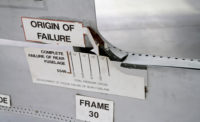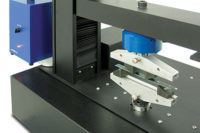
This is a typical configuration for testing the strength of lap shear specimens on a universal testing machine. Source: Admet
Adhesives come from either natural or synthetic sources. Some modern adhesives are extremely strong and are becoming increasingly important in electronic, construction and aerospace applications. The primary function of adhesives is to join parts together. Adhesives accomplish this by transmitting stress from one member (substrate) to another in a manner that distributes the stress more uniformly than can be achieved with mechanical fasteners. Adhesive bonding often provides joints that are mechanically equivalent to or stronger than those joined by fasteners.
For example, an assembly held together by rivets is limited by the strength of the material under the head of the rivets. The contact area between the substrates of an adhesive bond is usually much larger than the rivet underhead area. The result is an adhesive bond of equal or greater strength with lower and more uniform stress distributions.
Adhesives offer a number of advantages over mechanical fasteners:

Failure modes in adhesive joints are shown here. Source: Admet
Adhesive Joint Success and Failure
Careful preparation of the contact surfaces between substrates is vital for a strong bond, and surface treatments vary depending on the substrate material. Coatings or interstitial layers between the substrate and adhesive will result in weak bonds. Sunlight, heat and solvents may weaken an adhesive; load-induced stresses also may cause adhesive joint failure at different locations within the joint. If the failure occurs between the adhesive layer and one of the substrates, it is called adhesive failure.A failure in which the separation occurs in such a manner that both substrate surfaces remain covered with the adhesive is called a cohesive failure in the adhesive layer. Sometimes the adhesive bond is so strong that the failure occurs in one of the substrates away from the bond. This is called a cohesive failure of the substrate. Bond failures often involve more than one failure mode and are assigned a percentage of cohesive and adhesive failure.
The aim of joint design is to obtain maximum strength for a given bond area. Factors that affect joint design are the mechanical properties of the adhesive and substrate, residual stresses resulting from adhesive cure and the joint geometry. A good joint design should minimize stress concentrations, which reduce the overall strength of the joint.

Several types of load induced stresses in adhesive joints are shown here. All types are found in adhesive joints. Source: Admet
Types of Load-Induced Stresses in Adhesive Joints
Compression, tension, shear, peel and cleavage stresses are found in adhesive joints. Any combination of these stresses may be found in a given joint design. Compression loaded joints are limited in use, while peel and cleavage joints exhibit high stress concentrations along the leading edge of the joint boundary. As a result, cleavage and peel joints should only be used when large joint areas and small loads are present. Tension loaded joints distribute the stresses evenly over the joint area; however, peel or cleavage stresses frequently exist in tension joints due to offset loads. Shear loaded joints impose uniform stresses across the bonded area, resulting in the highest possible joint strength. As a result, adhesive joints should be designed to carry most of the load in shear.Lap Shear Joints
There are many types of adhesive joints for carrying shear loads. The most effective employ an overlapping substrate arrangement known as lap joints. The overlapping area should be large enough to enable the joint to withstand maximum shear service loads. Increasing the overlap length, L, beyond a certain amount has little effect on joint strength, whereas increasing the width, W, of the joint results in a proportional increase in joint strength.
More than 20 ASTM standards govern the testing of adhesives in shear. These are common lap shear joints. Source: Admet
Measuring the Shear Strength of a Lap Joint
The strength of a lap shear joint is usually measured by applying a tensile load with a universal testing machine to a lap shear specimen. More than 20 ASTM standards (see “ASTM Adhesive Shear Testing Specifications” sidebar) govern the testing of adhesives in shear. The reason for the multitude of shear specifications is that many methods to create and measure shear stresses have been developed, each applicable to different end-use applications. Some of these methods are further refined for certain material combinations, such as wood to wood and metal to metal, and environmental effects such as humidity and extreme heat or cold.Three common specifications used are ASTM D1002–Standard Test Method for the apparent shear strength of single lap joint adhesively bonded metal specimens by tension loading; ASTM D3163–determining strength of adhesively bonded rigid plastic lap-shear joints in shear by tension loading; and ASTM D3164–strength properties of adhesively bonded plastic lap shear sandwich joints in shear by tension loading.
ASTM D1002 is for metal substrates that are bonded by an adhesive. ASTM D3163 expands on D1002 for use with rigid plastic substrates. ASTM D3164 expands on both by allowing for substrates that have been joined by plastic rather than adhesive. All three of these specifications use a single lap joint (lap shear) specimen to determine the shear strength of adhesives.
Lap Shear Specimens
A lap shear specimen consists of two substrate plaques that have been joined by an adhesive on each end portion where the two substrates overlap. During the test, these substrates are pulled in opposite directions to produce a shearing stress on the adhesive used to join them. A 0.5-inch overlap is standard; however, the overlap length should be reduced if the yield point of the substrate is exceeded during a test. The length of the specimen in the jaws and the distance from the end of the lap to the end of the jaws must remain constant for all tests. Lap shear specimens are to be made in multiples of five. The group of five specimens is cut from one large lap shear specimen panel.Grips
Careful consideration should be given to the grips used to hold the lap shear specimen. Improper grip inserts and insert alignment can lead to grip slippage and cleavage stresses, respectively.Vice grips with serrated inserts are commonly used for lap shear tests. The serrated grip inserts are designed to dig into the material and prevent it from slipping. If slippage occurs with a vice grip, self-tightening grips of pneumatic or wedge design may be used. The grip inserts should be aligned so that the centerline of the grip assembly is aligned with the adhesive bond. Proper alignment is achieved with vice grips by adjusting the grip inserts from side to side so that the center line of the upper and lower grips pass through the adhesive.

This is a typical lap shear specimen according to ASTM D1002. This standard addresses apparent shear strength of single lap joint adhesively bonded metal specimens by tension loading. Source: Admet
Test Procedure
Many of the ASTM shear test specifications have their own unique test procedure, but most are similar to the following example.First, measure the amount of shear area in square inches or square centimeters. Second, load each end of the specimen in the tensile grips. Third, apply a force at a controlled rate to the specimen until it breaks and record the maximum force and type of joint failure. ASTM D1002 specifies a load control rate of 1,200 to 1,400 psi/minute. A crosshead control rate of 0.05 inch/minute approximates the loading rate and also is an acceptable mode of control.
The test report should include the maximum force recorded, maximum shear stress and the type of failure for each specimen. Maximum shear stress is found by dividing the maximum force by the shear area and is reported in units of kilogram/square centimeter or psi. Failure types include cohesion in the adhesive or metal substrate or adhesion.
Adhesives offer a number of advantages over mechanical fasteners, and thus are becoming increasingly important in electronic, construction and aerospace applications. For those interested in testing adhesives in shear, many methods to create and measure shear stresses have been developed, each for different applications. NDT
Tech Tips
Types of Adhesives
ASTM Adhesive Shear Testing Specifications
ASTM D905 - Strength Properties of Adhesive Bonds in Shear by Compression LoadingASTM D906 - Strength Properties of Adhesives in Plywood Type Construction in Shear by Tension Loading
ASTM D1002 - Apparent Shear Strength of Single-Lap-Joint Adhesively Bonded Metal Specimens by Tension Loading
ASTM D2293 - Creep Properties of Adhesives in Shear by Compression Loading (Metal-to-Metal)
ASTM D2294 - Standard Guide for Use of Adhesive-Bonded Single Lap-Joint Specimen Test Results
ASTM D2295 - Strength Properties of Adhesives in Shear by Tension Loading at Elevated Temperatures (Metal-to-Metal)
ASTM D2339 - Strength Properties of Adhesives in Two-Ply Wood Construction in Shear by Tension Loading
ASTM D2557 - Tensile-Shear Strength of Adhesives in the Subzero Temperature Range from -267.8 to -55 C
ASTM D2919 - Determining Durability of Adhesive Joints Stressed in Shear by Tension Loading
ASTM D3163 - Determining Strength of Adhesively Bonded Rigid Plastic Lap-Shear Joints in Shear by Tension Loading
ASTM D3164 - Strength Properties of Adhesively Bonded Plastic Lap-Shear Sandwich Joints in Shear by Tension Loading
ASTM D3165 - Strength Properties of Adhesives in Shear by Tension Loading of Single-Lap-Joint Laminated Assemblies
ASTM D3166 - Fatigue Properties of Adhesives in Shear by Tension Loading (Metal/Metal)
ASTM D3528 - Strength Properties of Double Lap Shear Adhesive Joints by Tension Loading
ASTM D3931 - Determining Strength of Gap-Filling Adhesive Bonds in Shear by Compression Loading
ASTM D4027 - Measuring Shear Properties of Structural Adhesives by the Modified-Rail Test
ASTM D4498 - Heat-Fail Temperature in Shear of Hot Melt Adhesives
ASTM D4501 - Shear Strength of Adhesive Bonds Between Rigid Substrates by the Block-Shear Method
ASTM D4562 - Shear Strength of Adhesives Using Pin-and-Collar Specimen
ASTM D5656 - Thick-Adhered Metal Lap-Shear Joints for the Stress-Strain Behavior of Adhesives in Shear
ASTM D5868 - Lap Shear Adhesion for Fiber Reinforced Plastic (FRP) Bonding
ASTM D6463 - Time to Failure of Pressure Sensitive Articles under Sustained Shear Loading

